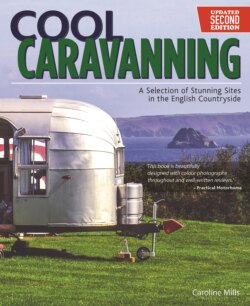Читать книгу Cool Caravanning, Updated Second Edition - Caroline Mills - Страница 11
На сайте Литреса книга снята с продажи.
ОглавлениеLound House Farm
North Yorkshire
Whitby, with St Mary’s Church in the background
The very mention of the word ‘moors’ sounds bleak and, indeed, there are parts of the North York Moors remote enough to find yourself entirely alone, a factor that should hardly be discouraging to visitors in a country where it gets progressively harder to grab a moment of solitude. The uplands are a product of millions of years of geological reorganization; they were given the glacial treatment for a little while before melting ice sliced through the rock, forming deeply gouged valleys with contradictory streamlets and jagged escarpments around the edge.
A sea of heather provides the Moors with a thick blanket of colour to brighten up the last days of summer and lead us cheerfully into autumn before returning the moors to their mixed tones of browns and beige for winter, when the frost casts a shiny veil over the bell-shaped plants, encouraging walkers to leave the comfort of the fire and head out to explore.
And an enthusiasm for travel is something the Moors have inspired for generations. Captain James Cook, one of England’s finest explorers, was a child of the North York Moors. His intrepid exploration and cartographic skills have put many a traveller’s ambitions and hastily scribbled directions on the back of a beer mat to shame. There are monuments and museums all over the moors dedicated to him, although surely the best way to show appreciation to the man is to get out a map and explore for ourselves?
Sea views from Lound House Farm
One of the best places from which to start any exploration is Lound House Farm. High on a hill, by a cluster of tiny villages on the edge of the Moors, it has sweeping views of Captain Cook’s frequent departure point, Whitby, and the Saltwick Bay coastline that runs south of the town. The campsite is virtually circular, the pitches working their way round the central farmhouse – a traditional, sturdy Yorkshire building made from the weather-blackened blocks of stone that are even stronger than a cup of Yorkshire tea. With a mixture of hardstanding and grass pitches, pretty much everyone gets a view of the sea, such is the curve of the coastline. And between the site and the cliffs lie field after field of green pastures and agricultural land with a small wood behind the site. It’s certainly quiet, and the small road that runs past only leads to a couple of tiny hamlets, so there’s more chance of hearing the twice-yearly visit of the tractor to the neighbouring field than the road.
It is, however, the views that make the site, and it has a deliberate policy of keeping things simple. There is a toilet and fresh water, but that’s about it. No showers, no play equipment (apart from the very best of rubber tyres tied to a tree and a large grass area for the imagination), no shop and no reception, other than the warm welcome that you’ll receive from the Bainbridges upon arrival.
Once the tea has brewed and it’s time to explore, take a trip up the coast road from Whitby to Staithes. It’s a tiny fishing village where the houses cling to the steep cliffs of a ravine like limpets and the power of the sea is evident on the rocks and in the tales told by the residents. It’s here that the boyish James Cook lived for a time, discovering his love of the sea before being let loose in Whitby. There’s a great Heritage Centre in the village, where a treasure trove of bits and pieces associated with his life have been collected along with a replica of the shop where he once worked.
Before making the heart-pounding walk back up the hill (Staithes is so tightly compact around the harbour that visitors must park at the top of the hill by the entrance to the village), prepare for your short journey by quenching your thirst at one of the pubs close to the harbour. They’re frequented by the village fishermen, so you may well hear tales of smuggling and stories, both tragic and heart-rending, of the sea and this close-knit community.
Lound House Farm
Littlebeck Lane, Whitby,
North Yorkshire, YO22 5HY
01947 810383
Opening times: Open all year (weather permitting)
Facilities: 35 pitches, hook-ups, toilets, cold-water taps, chemical toilet disposal point.
How to get there: Do not use SAT-NAV, rather follow this route in order to avoid steep hills and very narrow lanes. A171 to Whitby. In Whitby, turn onto B1416 signed for Ruswarp. Two miles past Ruswarp, turn right signed for Littlebeck. Site is half a mile farther on the right.
Food & drink: It has to be fresh Whitby fish and chips: Trenchers’, opposite the railway station and harbour, are ‘posh’ fish and chips; Hadleys’, over the bridge in the Old Town, are particularly fine. Quayside has previously won Fish and Chip Shop of the Year. For cooking in your own ‘van you can buy fresh fish from Sandgate Seafoods, on Sandgate.
Nearby attractions: Whitby Abbey and St Mary’s Church are landmarks in the town (and can be seen clearly from the campsite). Climb the famous steps to reach the abbey. Head to Goathland, one-time Aidensfield in Heartbeat, and set foot on the North Yorkshire Moors Steam Railway for a spectacular ride. For a geological wonder, visit the Hole of Horcum – a three-quarter-mile- wide crater and relic of the Ice Age – next to the A169.
Alternative campsite: Hooks House Farm (www.hookshousefarm.co.uk, tel.: 01947 880283). Lovely site with fantastic views of Robin Hood’s Bay (some road noise).
Top Left: The picturesque town of Whitby; Bottom Left: Sea views from Lound House Farm; Right: Good old-fashioned fun at the farm
